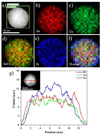Highly monodisperse multiple twinned AuCu-Pt trimetallic nanoparticles with high index surfaces
- PMID: 24975090
- PMCID: PMC4128576
- DOI: 10.1039/c4cp02208d
Highly monodisperse multiple twinned AuCu-Pt trimetallic nanoparticles with high index surfaces
Abstract
Trimetallic nanoparticles possess different properties than their mono- and bi-metallic counterparts, opening a wide range of possibilities for diverse potential applications with the notion to study possible morphology, atomic ordering, reduce precious metal consumption and many others. In this paper, we present a comprehensive experimental study on AuCu-Pt trimetallic nanoparticles with an average diameter of 15 ± 1.0 nm, synthesized in a one-pot synthesis method and characterized by the Cs-corrected scanning transmission electron microscopy technique that allowed us to probe the structure at the atomic level resolution. A new way to control the nanoparticle morphology by the presence of third metal (Pt) is also discussed by the overgrowth of Pt on the as prepared AuCu core by Frank-van der Merwe (FM) layer-by-layer and Stranski-Krastanov (SK) island-on-wetting-layer growth modes. With the application of this research, we are now a step closer to produce optimum catalysts in which the active phase forms only surface monolayers. In addition, the nanoalloy exhibits high index facet surfaces with {211} and {321} families that are highly open-structure surfaces and are interesting for the catalytic applications.
Figures





Similar articles
-
One-pot synthesized Cu/Au/Pt trimetallic nanoparticles with enhanced catalytic and plasmonic properties as a universal platform for biosensing and cancer theranostics.Chem Commun (Camb). 2019 Feb 19;55(16):2321-2324. doi: 10.1039/c8cc10127b. Chem Commun (Camb). 2019. PMID: 30720028
-
Surface enhanced vibrational spectroscopy and first-principles study of L-cysteine adsorption on noble trimetallic Au/Pt@Rh clusters.Phys Chem Chem Phys. 2015 Sep 7;17(33):21268-77. doi: 10.1039/c4cp05170j. Epub 2015 Feb 4. Phys Chem Chem Phys. 2015. PMID: 25650352
-
Synthesis of highly active and stable Au-PtCu core-shell nanoparticles for oxygen reduction reaction.Phys Chem Chem Phys. 2012 Nov 14;14(42):14696-701. doi: 10.1039/c2cp42716h. Epub 2012 Oct 2. Phys Chem Chem Phys. 2012. PMID: 23032948
-
Pt based nanocomposites (mono/bi/tri-metallic) decorated using different carbon supports for methanol electro-oxidation in acidic and basic media.Nanoscale. 2011 Aug;3(8):3334-49. doi: 10.1039/c1nr10273g. Epub 2011 Jun 30. Nanoscale. 2011. PMID: 21717025
-
Platinum-based oxygen reduction electrocatalysts.Acc Chem Res. 2013 Aug 20;46(8):1848-57. doi: 10.1021/ar300359w. Epub 2013 Jun 28. Acc Chem Res. 2013. PMID: 23808919 Review.
Cited by
-
Synthetic control over lattice strain in trimetallic AuCu-core Pt-shell nanoparticles.Nanoscale. 2025 Mar 24;17(12):7100-7113. doi: 10.1039/d4nr04424j. Nanoscale. 2025. PMID: 39903214 Free PMC article.
-
Starch-mediated synthesis of mono- and bimetallic silver/gold nanoparticles as antimicrobial and anticancer agents.Int J Nanomedicine. 2019 Mar 27;14:2171-2190. doi: 10.2147/IJN.S192757. eCollection 2019. Int J Nanomedicine. 2019. PMID: 30988615 Free PMC article.
-
Essential Oils and Mono/bi/tri-Metallic Nanocomposites as Alternative Sources of Antimicrobial Agents to Combat Multidrug-Resistant Pathogenic Microorganisms: An Overview.Molecules. 2020 Feb 27;25(5):1058. doi: 10.3390/molecules25051058. Molecules. 2020. PMID: 32120930 Free PMC article. Review.
-
Single Step Laser-Induced Deposition of Plasmonic Au, Ag, Pt Mono-, Bi- and Tri-Metallic Nanoparticles.Nanomaterials (Basel). 2021 Dec 31;12(1):146. doi: 10.3390/nano12010146. Nanomaterials (Basel). 2021. PMID: 35010096 Free PMC article.
-
Synthesis, characterization, and growth simulations of Cu-Pt bimetallic nanoclusters.Beilstein J Nanotechnol. 2014 Aug 27;5:1371-9. doi: 10.3762/bjnano.5.150. eCollection 2014. Beilstein J Nanotechnol. 2014. PMID: 25247120 Free PMC article.
References
-
- Toshima N, Ito R, Matsushita T, Shiraishi Y. Catal. Today. 2007;122:239–244.
-
- Tsai S-H, Liu Y-H, Wu P-L, Yeh C-S. J. Mater. Chem. 2003;13:978–980.
-
- Toshima N. Macromol. Symp. 2008;270:27–39.
-
- Ding Y, Gao Y, Wang ZL, Tian N, Zhou Z-Y, Sun S-G. App. Phys. Lett. 2007;91 121901-121901-121903.
Publication types
MeSH terms
Substances
Grants and funding
LinkOut - more resources
Full Text Sources
Other Literature Sources

